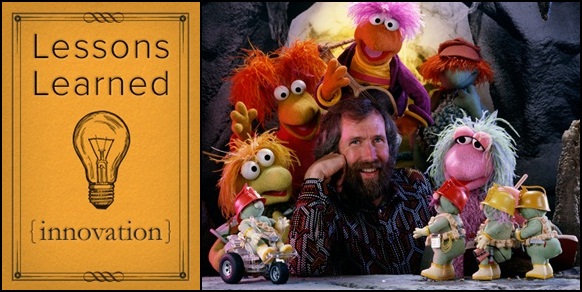On Writing the Story of Muppet Master Jim Henson
By Brian Jay Jones

Jim Henson and The Fraggles
Editor’s Note: Brian Jay Jones is an award-winning biographer and vice president of Biographers International Organization, as well as a devoted member of the Jim Henson generation, having been two years old when “Sesame Street” premiered in 1969 and nine when “The Muppet Show” debuted in 1976. A former policy analyst and advisor in the U.S. Senate, Jones abandoned politics for the pen in 2008, with the publication of his award-winning biography, Washington Irving. He lives with his wife and daughter in Damascus, Maryland. His favorite Muppet is Rowlf (thanks for asking). Here, Jones shares the lesson he learned while writing the first-ever comprehensive bio of Jim Henson, in celebration of Biographile’s Lessons Learned month. See all posts in Biographile's Lessons Learned series here.
In 1825, the American writer Washington Irving – already one of the most famous and respected authors in the world – was asked if he might be interested in writing a biography of George Washington. Irving responded in a near panic. It would take too much serious research, he said apologetically, and the subject itself was too iconic, too intimidating. “I stand in too great awe of it,” Irving finally explained.
I know how he feels. I felt that way, too – at least at first – about writing the first biography of Jim Henson. He and his work have been part of my life – and probably part of yours – for as long as I can remember. We know the face, probably recognize the signature – like Walt Disney, his company logo is still built around it – and we definitely know his work and the characters he created, whether it’s Kermit the Frog, Rowlf the Dog, Ernie and Bert, or the richly realized worlds of “Fraggle Rock” and “The Dark Crystal.” Moreover, most of us tend to have warm feelings about Jim Henson and his creations. For pretty much that last reason alone, then, I found the idea of telling his story both thrilling and intimidating. How does one take on an icon, especially one beloved my millions? Fortunately, I had one thing working in my favor that other biographers didn’t.
I had Jim Henson.
Henson was great at what he did – and knew it – but he was also incredibly modest and never pretended to have all the answers. One of Jim Henson’s greatest talents, said Muppet writer Jerry Juhl, was “the ability not to take most things more seriously than they deserved ... [which means] most things are pretty funny.” Throughout his life, Jim stressed that life was to be enjoyed, and that it was important from time to time to step back, look things over, and not take anything or anyone too seriously – not even him. Truly, it takes an extraordinary human being to keep assuring you that he’s just a man – and for a biographer, it’s a constant reminder not to “stand in too great awe” of your subject while you’re working.
Jim also knew he wasn’t perfect. For the most part, Jim’s pretty much exactly as you want him to be: genuinely kind, dazzlingly inspirational, and immensely talented. But he was also, as Muppet performer Frank Oz noted, “delightfully imperfect.” Capturing that sort of delightful imperfection was vital to painting the most complete portrait of Jim that I possibly could. It was critical, then, to explore not only his geniality and generosity, but also his faults and flaws, and to do so openly, frankly, and – so I always hope – respectfully.
In truth, there weren’t many flaws: Jim loved collecting expensive art, delighted in pricey cars, almost pathologically avoided conflict, and – perhaps his most flagrant blemish – he wasn’t always an entirely faithful husband. But while Jim tried to be discreet about his shortcomings, he never denied them; to him, they were simply part of the overall human experience – to be worked through, said Jim, “and hopefully, come out a bit wiser and better.”
Faults and flaws are just as much a part of life as kindness and collaboration. Imperfections provide a contrast that makes the colors in a life shine that much more brightly – especially a life as wonderfully vibrant and complex as Jim Henson’s.
For all Lessons Learned articles, visit the archive.
